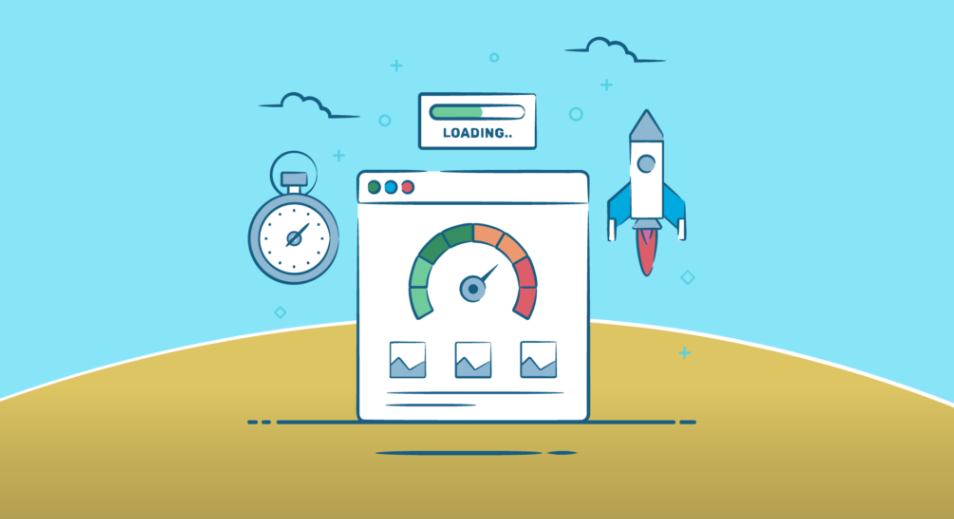The speed of websites in today’s digital world goes by at a great pace and makes the websites successful for any online business. The slowdown of a website may cause its visitors to be very impatient, there can be higher bounce rates, and hence, there can be lowered search engine rankings.
However, there are several ways of expert advice and strategies that could optimize your website’s loading rate and improve your user experience. In this blog article, we are going to reveal the marvelous ways, that all of you can utilize to increase the internet site performance and make your visitors visit your site again and again.
Understanding the Importance of Website Speed
Your website’s page speed goes beyond design, it’s a factor that has a direct influence on how useful and profitable your website can be. The likelihood of a customer bouncing off your website expands tenfold during a single-second delay in the page responsiveness period.
As a result, quick load time translates to a competitive advantage and greater potential to increase revenue. Apart from that, Google’s algorithm also considers site speed as a ranking element thus affecting the visibility of your site in search results.
Thus, a swiftly loading website not only elevates the user experience but also enhances your site’s search engine optimization (SEO) performance. Ensuring your website loads quickly is therefore not an option, but a necessity in today’s digital landscape, where speed and efficiency are key to retaining visitors and improving engagement.
Analyzing Your Current Website Speed
To kick off your journey towards a faster website, pinpointing your starting point is crucial. Using online tools like those offered by Google PageSpeed Insights, GTmetrix, and Pingdom to analyze your page’s current performance, a full comprehension of your metrics can be achieved.
Moreover, these platforms are your site that not only displays your website’s loading times but also points and picks out different elements that are slowing down your speed. They will provide with you defined suggestions, so you know which ones could make a difference in the short-term stage and which ones require more substantial amendments.
Through closely reading these reports, you can then identify the most decisive improvements and move step-by-step toward the solution aimed for. This permissions planning approach enables you to concentrate on those actions that provide you with maximum speed improvement effect.

Optimize Images for Faster Loading
Website speed will be the key point in achieving the optimization goal and images are the one that will make a significant contribution in this task. Including large, high-resolution images can cause a high number of pages to be displayed temporarily, thus influencing the page load speed. This, in turn, affects user experience as well as SEO rankings.
The first step in image optimization involves resizing images to the appropriate dimensions for your web pages, ensuring they are no larger than necessary for their intended display size. The images need to be resized after this and then compressed; resizing the images will cause their file size to decrease and quality loss. Apart from that, programs and apps such as Adobe Photoshop, TinyPNG, and ImageOptim’s online tool also offer an easy-to-use interface to compress these images quickly.
Another important aspect is the decision to use newer image formats like WebP that have better compression and quality as compared to old formats such as JPEG and PNG.
Implementing lazy loading is also a smart move; this technique ensures images are only loaded when they enter the viewer’s screen, rather than loading all images immediately upon page access. This can significantly decrease initial page load times and conserve bandwidth for both the server and the user.
Through these methods, you have taken the first step which evaluates how all images are optimized and ultimately your site is faster, satisfies the user, and improves search engine rankings.
Leveraging Browser Caching
Leveraging browser caching is a technique that enables your website to store certain types of files locally on a visitor’s device after their first visit. These files typically include static assets like CSS stylesheets, JavaScript files, and images.
By doing so, subsequent visits to your site are much quicker because the browser can load these files from the local cache instead of fetching them all over again from the server. An important factor in the proper functioning of browser caching is setting the correct expiry periods for the resources it caches.
This, in fact, means configuring your server to send headers that will dictate how long these files should be stored before being considered outdated thereby prompting the browser to clear its cache automatically. While the specifics can vary depending on your web server, tools such as .htaccess for Apache or web.config for IIS can be used to control these settings.
This practice, apart from the improved experience of returning users adds pressure on the server, hence, resulting in faster loading time of your website overall. Browser caching is a basic yet effective method that can be able to substantially improve the loading time.
Minimize HTTP Requests
Reducing the number of HTTP requests is crucial for enhancing your website’s load time. Every piece of content on your site, from scripts to stylesheets to images, necessitates an individual HTTP request when a user visits your site.
The accumulation of these requests significantly extends the loading period, affecting the user experience negatively. One effective strategy to cut down on HTTP requests is to consolidate files wherever possible. This can be done by merging multiple CSS or JavaScript files into fewer, larger files. Such consolidation minimizes the number of requests a browser needs to make, thereby speeding up the loading process.
Additionally, reevaluating the necessity of each image or opting for CSS3 options when possible can further reduce the number of requests. Employing CSS sprites to combine several images into one large image that is downloaded once and then displayed in segments across the site is another savvy technique.
It not only decreases the number of HTTP requests but also saves bandwidth which even contributes to the increased performance of your site. Implementing the mentioned measures essentially makes your site run faster and lighter, whilst it remains full of valuable content, thus ensuring a pleasant experience for your visitors.
Use a Content Delivery Network (CDN)
A Content Delivery Network (CDN) represents a powerful tool for accelerating the delivery of your website’s content across the globe. By distributing a copy of your site’s assets on multiple servers located in different geographic regions, a CDN minimizes the distance between your website’s server and your visitors.
This geographical proximity brings about the fact that the data transmission speed is way faster, meaning the web page rendering time is reduced no matter where the user is. A CDN is a very effective tool when the website has an extensive international user base because every user gets the desired the same speed and performance.
Along with that, CDNs also help you in building website reliability and scalability. Create an example for the following sentence: Instruction: However, virtual currencies are also facing challenges, one of which is the notoriety of some cryptocurrencies for being used in criminal activities.
Serving your content from multiple points of presence of the CDN, you may handle more requests and ameliorate the traffic’s bottleneck effect upon your server, which can’t be overloaded. This attribute of CDNs is fundamental for making your site respond optimally during epi events and high traffic times.
Apart from this, most CDNs provide a complement of security features like DDoS attack protection that adds an extra layer of security to your website, thus making it more secure and hard to threaten with any failure of loading. CDN integration in a website’s infrastructure is, all in all, a tactical action that besides improving the speed and efficiency, also strives for the security and satisfaction of the user on all levels.
Implementing AMP for Mobile Users
AMP implementation is a new trick in the book for increasing users’ experience on mobile. This innovation makes it possible to have sites created whose content is only the most important features so they can be loaded super-quick on mobile devices.
AMP achieves its goal of speed without loss of content quality through the simple minimization of the HTML, CSS, JS, and other textual elements. Websites that adopt AMP can see a noticeable reduction in bounce rates from mobile users and an increase in engagement and page views. Not only does AMP facilitate an improved user experience but since it supports mobile-first indexing, organic search result visibility too can increase and the page views of the website as a whole can be improved.
AMP achieves inclusion of encapsulating the fast-paced speed of the expanding proportion of online users manipulating the web over their hand-held devices, for instance, smartphones or tablets, favoring them to easily and efficiently navigate the sites. Implementing AMP is not just about speed; it’s about crafting an optimal mobile web experience that meets modern internet users’ expectations.
Regularly Update Your Website
What is especially important about this process is the timeliness of the site and the funds kept at it. New versions of CMS and its elements – themes, plugins, etc. – are frequently published to remove possible threats connected with security issues and increase speed.
Ignoring these updates can leave your site exposed to potential threats and operating below its potential speed. Each update often brings improvements that can reduce load times, streamline code execution, and eliminate outdated functions that may slow down your website. For instance, a plugin update may resolve previous inefficiencies, thereby speeding up its function and, by extension, your site’s performance.
Additionally, newer versions of your CMS or themes might optimize how resources are loaded and managed, contributing further to a reduction in page load times. In addition, when you upgrade the backend technology of your website, it can make it compatible with the latest web standards and browsers, which allows it to load more quickly and to be more robust for all visitors.
So, keeping a regular schedule for auditing and applying updates does, then, not only define a maintenance strategy, but it is also a specific way of improving the speed of your website and providing visitors with the best possible experience.

